THE CREATION OF DCA
1947-1960
POST WORLD WAR II/COLD WAR
The quest for centralization of military communications goes back to World War II (WWII), with a push for the development of military communications that were common-user. Military communications of WWII centered on three main technologies: wire, radio (wireless), and radar. Systems were general purpose in nature, serving the needs of a host of users at a number of geographic locations and capable of sending message traffic of all types and precedence. The global scale and rapid pace of actions during WWII required large-scale coordination within the U.S. armed forces as well as between our forces and those of our allies.
While common-user communications systems had distinct advantages over those communications systems that were "dedicated" to a single use (and were frequently viewed as inherently limited), not all were in support of the common-user communication systems. Most notably the military services were unhappy with common-user systems for the precise reason that they were designed to serve the communications needs of others and were thus not fully under one's own respective control. In short, common-user systems necessitated accommodation by the services and this was viewed as undesirable.
The main issue was the precedence of the messages. Normally, a message's precedence level would determine how fast it would be processed. However service parochialism tended to nullify order of precedence as users inflated the level of importance or precedence to get their respective messages through, thereby choking the communications systems. With the end of WWII, the United States emerged as the preeminent world power and its military services assumed roles that reflected global responsibilities. While requiring the need for worldwide communications systems, the services were leery of common-user systems based upon their WWII experience. For this reason, the services began to develop sets of dedicated communications networks to meet the needs of their own individual mission-specific requirements. Thus, a dichotomy of doctrine was established between the supporters of common-user and dedicated-user communication systems and technologies.
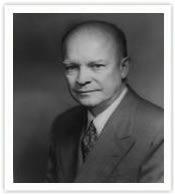
President Dwight D. Eisenhower |
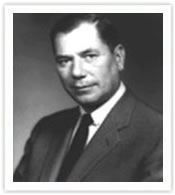
Secretary of Defense Thomas Gates |
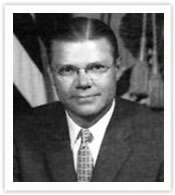
Secretary of Defense Robert S. McNamara |
While the military service departments wished to remain autonomous, the need for a centralized command structure was recognized early after the war. The National Security Act of 1947 officially reorganized the defense establishment. The Act created a separate Air Force department and replaced the Secretary of War with the Secretary of Defense (SECDEF). The SECDEF position sought to exercise general direction, authority and control over the three military service departments, and to serve as the President's principal assistant in national security matters. The Joint Chiefs of Staff (JCS), established during WWII as the supreme military body for directing the allied war effort, was provided a statutory basis and was designated the principal military advisor to the Secretary of Defense and the President. The creation of these new organizations was a result of the lessons learned from the war; chief among these lessons was that new weaponry made obsolete the older concepts of separate ground, sea, and air warfare. Future wars would consist of the operations of joint forces instead of the operations of separate forces.
These new organizations in the Department of Defense (DoD) with their own considerable communications needs also worked to complicate the national military defense structure during the 1950s. While the military services were thinking globally, at least from their own perspectives, they still developed their respective communications systems with a reliance on a doctrine of dedicated communications that nonetheless restricted and delayed a true global capability. Something had to be done to break the communications log jam. Attempts to modernize and automate processes and technologies; however, were often resisted by those who had a stake in the status quo. President Dwight D. Eisenhower believed that the military departments were the primary obstacle to more effective, centralized defense management. This belief became the driving force behind his administration's long effort to reform DoD.
In 1957, President Eisenhower ordered his Secretary of Defense, Charles E. Wilson, to survey military communications and to report "...on the possibility of eliminating any duplication of such facilities..." The DoD initially responded with an agreement and promulgated a directive on telecommunications policy that declared: "...It is the general objective of the Department of Defense to assume an integrated telecommunications system composed of inherently compatible elements that will economically, efficiently, and effectively satisfy National Defense requirements..." The following year Congress passed the Defense Reorganization Act of 1958. In 1959 the JCS requested the SECDEF approve a concept for a joint military communications network to be formed by consolidation of the communications facilities of the Military Departments. This would ultimately lead to the formation of the Defense Communications Agency (DCA).
The Defense Communications Agency
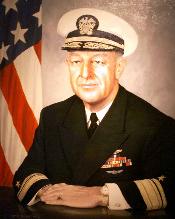
Navy Rear Admiral William D. Irvin,
First Director of DCA |
DCA was established May 12, 1960 with the primary mission of operational control and management of the Defense Communications System (DCS).
The initial core of 34 DCA members was gathered at Wake Hall, one of a complex of three buildings (which included Midway Hall and Guam Hall) on the site where the parking lot of the Robert F. Kennedy Stadium in Washington, D.C. stands today.
Navy Rear Admiral William D. Irvin (pictured left) became the first DCA director in July. In September, Rear Admiral Irvin moved his staff to office space in Building 12 at the Naval Services Center, 701 Courthouse Road, in Arlington, Va., the site of the U.S. Navy’s old Radio Arlington Station.
Built originally as a warehouse for long-term storage, Building 12 was rudimentary in its early accommodations. DCA occupied space on the third and fourth floors; the basement area was a parking garage for government vehicles “The building is not platinum-plated,’ remarked Rear Admiral Irvin, ‘despite what the Bureau of Docks and Yards claim.”
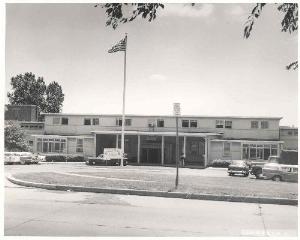
Wake Hall, DCA (DISA) Headquarters, May to September 1960 |
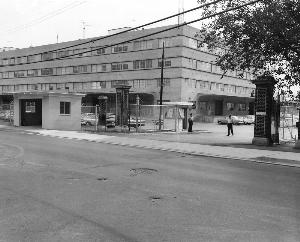
DCA Headquarters, Courthouse Road, 1965 |